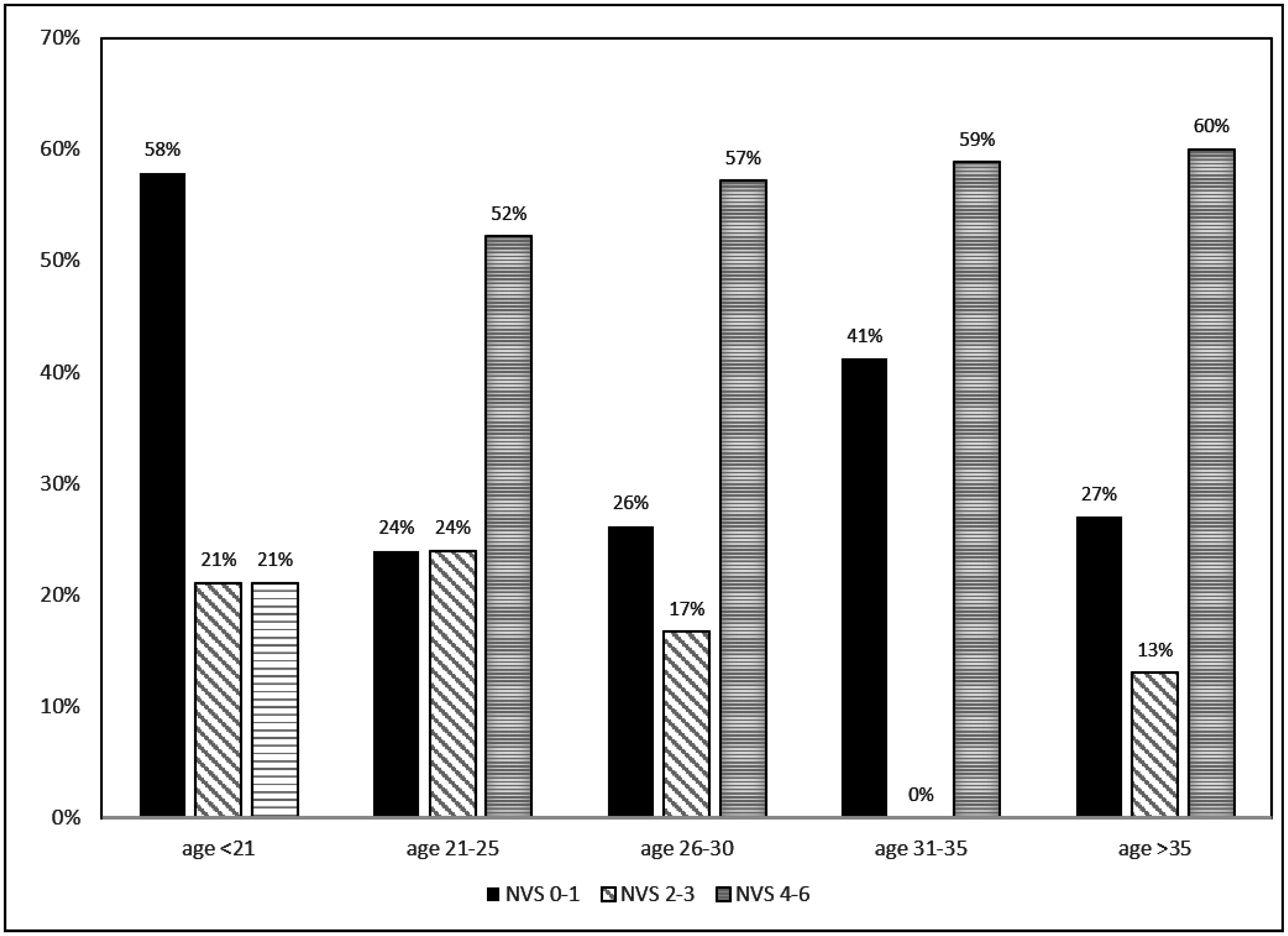Health Literacy in Obstetric Patients: A Pharmacist’s Experience with The Newest Vital Sign
Abstract
:1. Introduction
2. Experimental Section
3. Results and Discussion
| Total | NVS score | p-value | |||
|---|---|---|---|---|---|
| 0–1 | 2–3 | 4–6 | |||
| Age (years), mean ± SD (range) | 27 ± 6 (16–49) | ||||
| < 21 | 19 (14%) | 58% | 21% | 21% | 0.046 |
| 21–25 | 46 (33%) | 24% | 24% | 52% | |
| 26–30 | 43 (31%) | 26% | 16% | 58% | |
| 31–35 | 17 (12%) | 41% | 0% | 59% | |
| > 35 | 15 (11%) | 27% | 13% | 60% | |
| Race | |||||
| White | 70 (50%) | 26% | 11% | 63% | 0.022 |
| Non-white | 70 (50%) | 37% | 23% | 40% | |
| NVS, mean ± SD (range) | 3 ± 2.2 (0–6) | ||||
| 0–1 | 44 (31%) | ||||
| 2–3 | 24 (17%) | ||||

Limitations
4. Conclusions
Acknowledgements
Conflicts of Interest
References
- Ragland, D.; Briggs, G.G.; Wasik, M.; Kelsy, J.J.; Ferreira, E.; Abe-Fukushima, W.; Kelly, B.D.; Nageotte, M. Obstetrical opportunities: Will pharmacy ever realize them? Ann. Pharmacother. 2012, 46, 297–300. [Google Scholar] [CrossRef] [PubMed]
- Schillinger, D.; Machtinger, E.; Wang, F.; Rodriquez, M.; Bindman, A. Preventing Medication Errors in Ambulatory Care: The Importance of Establishing Regimen Concordance; Agency for Healthcare Research and Quality: Rockville, MD, USA, 2005.
- Institute of Medicine. Health Literacy: A Prescription to End Confusion; National Academies Press: Washington, DC, USA, 2004. [Google Scholar]
- Weiss, B.D.; Mays, M.Z.; Martz, W.; Castro, K.; DeWalt, D.A.; Pignone, M.P.; Mockbee, J.; Hale, F.A. Quick assessment of literacy in primary care: The newest vital sign. Ann. Fam. Med. 2005, 3, 514–522. [Google Scholar] [CrossRef] [PubMed]
- Shah, L.C.; West, P.; Bremmeyer, K.; Savoy-Moore, R.T. Health literacy instrument in family medicine: The “newest vital sign” ease of use and correlates. J. Am. Board. Fam. Med. 2010, 23, 195–203. [Google Scholar] [CrossRef] [PubMed]
- Committee Opinion No. 585: Health Literacy. Obstet. Gynecol. 2014, 123, 380–383.
- Williams, M.V.; Baker, D.W.; Parker, R.M.; Nurss, J.R. Relationship of functional health literacy to patients’ knowledge of their chronic disease: A study of patients with hypertension and diabetes. Arch. Inter. Med. 1998, 158, 166–172. [Google Scholar] [CrossRef]
- Baker, D.W.; Parker, R.M.; Williams, M.V.; Clark, W.S. Health literacy and the risk of hospital admission. J. Gen. Intern. Med. 1998, 13, 191–199. [Google Scholar] [CrossRef]
- Williams, M.V.; Parker, R.M.; Baker, D.W.; Parish, N.S.; Pitkin, K.; Coates, W.C.; Nurss, J.R. Inadequate health literacy among patients at two public hospitals. JAMA 1995, 274, 1677–1682. [Google Scholar] [CrossRef] [PubMed]
- Gazmararian, J.A.; Baker, D.W.; Williams, M.V.; Parker, R.M.; Scott, T.L.; Green, D.C.; Fehrenbach, S.N.; Ren, J.; Koplan, J.P. Health literacy among Medicare enrollees in a managed care organization. JAMA 1999, 281, 545–551. [Google Scholar] [CrossRef] [PubMed]
- Vernon, J.A.; Trujillo, A.; Rosenbaum, S.; DeByono, B. Low health literacy: Implications for national health policy. 2007. Available online: http://publichealth.gwu.edu/departments/healthpolicy/CHPR/downloads/LowHealthLiteracyReport10_4_07.pdf (accessed on 25 February 2015).
- Department of Health and Human Services. Healthy People 2020. Available online: http://www.healthpeople.gov/2020/default.aspx (accessed on 25 February 2015).
- Department of Health and Human Services. Office of Disease Prevention and Health Promotion. National action plan to improve health literacy; Department of Health and Human Services: Washington, DC, USA, 2010.
- Koh, H.K.; Berwick, D.M.; Clancy, C.M.; Baur, C.; Brach, C.; Harris, L.M.; Zehursen, E.G. New federal initiatives to boost health literacy can help the nation move beyond cycle of costly “crisis care”. Health Aff. 2012, 31, 434–443. [Google Scholar] [CrossRef] [PubMed]
- Center for Health Care Strategies. Health Literacy Implications of the Affordable Care Act; Center for Health Care Strategies: Hamilton, NJ, USA, 2010. [Google Scholar]
- Lai, E.; Trac, L.; Lovett, A. Expanding the Pharmacist’s Role in Public Health. Univ. J. Pub. Health 2013, 1, 79–85. [Google Scholar]
- Langer Research Associates. Medication Adherence in America: A National Report Card; National Community Pharmacists Association: Alexandria, VA, USA, 2013. [Google Scholar]
- The Newest Vital Sign. Available online: http://www.pfizer.com/health/literacy/public_policy_researchers/nvs_toolkit (accessed on 23 November 2015).
© 2015 by the authors; licensee MDPI, Basel, Switzerland. This article is an open access article distributed under the terms and conditions of the Creative Commons Attribution license (http://creativecommons.org/licenses/by/4.0/).
Share and Cite
Ragland, D.; Payakachat, N. Health Literacy in Obstetric Patients: A Pharmacist’s Experience with The Newest Vital Sign. Pharmacy 2015, 3, 372-378. https://doi.org/10.3390/pharmacy3040372
Ragland D, Payakachat N. Health Literacy in Obstetric Patients: A Pharmacist’s Experience with The Newest Vital Sign. Pharmacy. 2015; 3(4):372-378. https://doi.org/10.3390/pharmacy3040372
Chicago/Turabian StyleRagland, Denise, and Nalin Payakachat. 2015. "Health Literacy in Obstetric Patients: A Pharmacist’s Experience with The Newest Vital Sign" Pharmacy 3, no. 4: 372-378. https://doi.org/10.3390/pharmacy3040372






